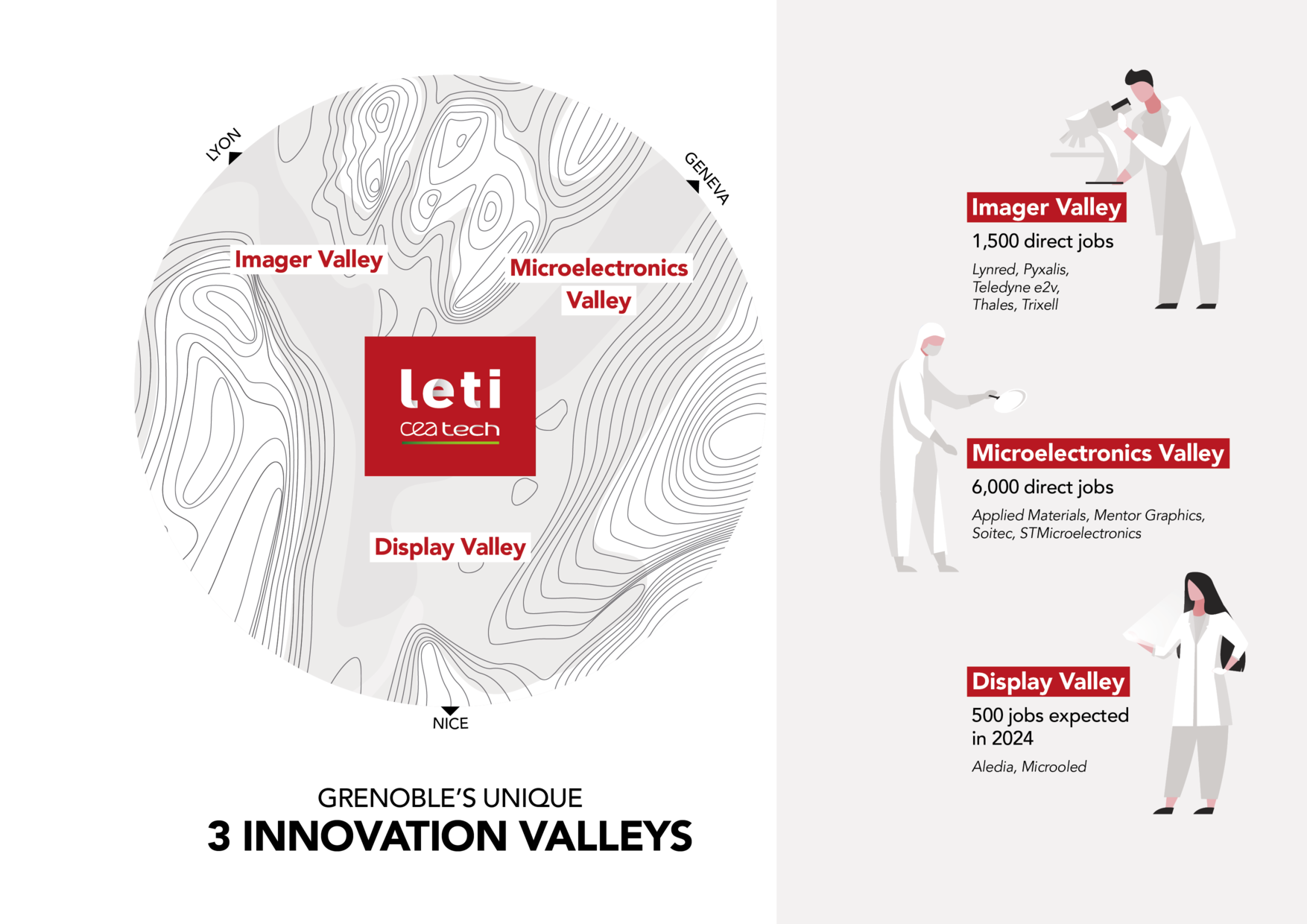With over 80% of its revenue in export markets, and 8,000 direct, highly-skilled jobs, the Grenoble Alpes ecosystem - a flagship for French-made nanotechnologies - remains unaffected by the economic crisis. So where does its specificity lie? In bringing together, in one region and around a world-renowned research center - CEA-Leti - a majority of players from the silicon technology value chain. But also in spreading its wings across three complementary valleys: the microelectronics valley, the imagery valley and, more recently, the valley of displays.

To begin with, a word on CEA-Leti. Created in 1967, it has become one of the world’s leading research hubs in micro and nanoelectronics and employs 1,900 people. Seventy startups have grown from its roots, among them several flagships that have chosen to stay close to their origins. They set up just a few kilometers away, in the three valleys, marking out another Y-shape to associate with Grenoble, this time the Y of cutting-edge industry.
To the East, in the direction of Geneva (Switzerland), the first valley is home to Soitec, created in 1992 by four employees from CEA-Leti, and STMicroelectronics, a heavyweight in the semiconductor market. The former supplies cutting-edge materials, while the latter designs and manufactures consistently smaller and more advanced integrated circuits. In 2021, the valley provides over 8,000 jobs. Its capacity to sell its products all over the world has attracted multinational companies.
- From infrared imagers to display
To the North, in the direction of Lyon, the infrared expert Lynred employs some 1,000 people. It is composed of two companies, one of which - Ulis - started out at CEA-Leti. Its bolometers and imagers capture, measure and digitize data. The valley is also home to another manufacturing plant employing 2,000 people - Thales, which makes imagers.
To the South, in the direction of Nice, the valley of displays is burgeoning thanks to Aledia, another CEA-Leti startup. There are currently 120 people working at the R&D center in Échirolles, just a few kilometers from the institute. A little further away, a production plant for next-generation displays is currently being built. By 2024, it will employ 560 employees. As the latest celebrity of the French deep tech sector, Aledia achieved the largest fundraising figure for a startup in 2020: 120 million euros.
- One direct job = three to five indirect jobs
This Y-shaped geographic location, valley-specific specialization, and innovative ecosystem is a winning model. And that is because the companies mentioned here do not just inhabit their premises to conduct business, they feed into a virtuous circle.
They create wealth locally: each direct job generates between three and five indirect jobs. They continue to work with CEA-Leti: joint laboratories for Lynred and Aledia; an R&D partnership with STMicroelectronics, which has continued uninterrupted for 40 years. Soitec has a number of partnerships underway and a joint laboratory is developing new substrates, with a view to reducing R&D time even further.
- A culture ‘cleanroom’ culture with highly qualified employment
Why did these companies choose Grenoble, when they would have been welcomed with open arms anywhere else in the world? Exactly because this interaction with their ecosystem is a vital factor in their capacity to innovate. And they do not stop at R&D. Leading researchers from CEA-Leti regularly join their ranks and, in return, experts from these companies sometimes work with CEA-Leti, helping it stay in tune with the industry’s demands.
In Grenoble, there is also a unique culture of qualified industrial employment and the cleanroom environment. When setting up its plant, Aledia was courted by a number of cities, both in France and abroad. In spite of this, the company decided to remain at the heart of this ecosystem. What's more, the Auvergne-Rhône-Alpes region is fully aware of the economic stakes at play in the golden age of chips: it invests in the Grenoble region's engineering schools and in research equipment and infrastructure, including CEA-Leti.
In a global microelectronics market worth 450 billion dollars, Grenoble has forged a prime position in the More than Moore sector. It is a key player in low power, for example, at a time when forecasts suggest there will be 125 billion IoT connected devices in use worldwide in 2030.
Our system has a center, CEA-Leti, three branches spreading out into three valleys; and, most importantly, a stability and collective force that fuel our optimism. In the face of the incredible acceleration of digital technology we have seen in the last year, Grenoble stands at the ready.